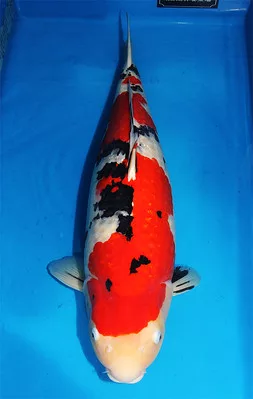
The Enchanting Sanke Koi: A Splash of Color and Symbolism
Koi fish, with their vibrant colors and graceful movements, are some of the most popular ornamental fish in the world. Among these captivating creatures, the Sanke koi stands out for its unique and striking tri-colored pattern. Let’s delve into the beauty and characteristics of this mesmerizing fish.
The Enchanting Sanke Koi: A Tri-Colored Treasure for Your Pond
The Sanke koi fish, also known as the Taisho Sanshoku, is a truly mesmerizing sight to behold. With its captivating tri-color pattern of white, red, and black, this koi variety exudes an air of elegance and grace that has captivated koi enthusiasts for generations.
A History Steeped in Tradition
The Sanke’s origins can be traced back to the Taisho era in Japan, around 1918. It is believed to have emerged from selective breeding of Kohaku koi, resulting in the addition of striking black markings to the classic white and red combination. The name “Sanke” itself signifies “three colors” in Japanese, aptly reflecting the koi’s distinctive color palette.
A Kaleidoscope of Colors
The ideal Sanke koi boasts a flawless white base, adorned with vibrant red patches known as “hi” and bold black markings called “sumi.” The red hi should be well-defined and evenly distributed, resembling scattered brushstrokes of crimson across the koi’s body. The black sumi, on the other hand, should be deep and lacquer-like, adding a touch of contrast and drama to the overall appearance.
Variations on a Theme
While the classic Sanke pattern is undeniably captivating, there are several fascinating variations that add to the koi’s allure. The Aka Sanke, for instance, features a continuous red pattern that extends from the head to the tail, while the Tancho Sanke showcases a single, circular red patch on the head, reminiscent of the Japanese national bird.
Beyond Beauty: Symbolism and Significance
In Japanese culture, koi fish are revered symbols of strength, perseverance, and good luck. The Sanke koi, with its tri-color combination, further embodies these attributes. The white represents purity and peace, the red signifies vitality and good fortune, and the black denotes power and protection. Owning a Sanke koi is thus considered auspicious, bringing harmony and prosperity to the owner.
Caring for Your Sanke Koi
If you’re considering adding a Sanke koi to your pond, it’s crucial to provide them with the proper care to ensure their health and well-being. These koi require spacious ponds with excellent water quality, a balanced diet, and a comfortable water temperature range. With proper care, your Sanke koi can thrive for many years, gracing your pond with their mesmerizing beauty and symbolic significance.
A Journey Through Time: The Origins of the Sanke Koi
The Sanke koi, also known as the Taisho Sanke, originated in Japan during the early 20th century. Its name, “Sanke,” translates to “three colors,” reflecting the white, red, and black markings that adorn its body. Each color holds symbolic meaning:
- White: Purity and cleanliness
- Red: Passion and vitality
- Black: Power and strength
Together, these colors create a mesmerizing contrast, making the Sanke koi a true favorite among enthusiasts.
A Mark of Distinction: The Sanke’s Pattern
What truly sets the Sanke koi apart is its distinctive pattern. Ideally, the colors should be evenly distributed and balanced, with no single color dominating the others. The white base should be a pristine white, while the red and black markings should be bold and vibrant. Additionally, the markings should be well-defined, not blending into each other.
Graceful Giants: Size and Lifespan
Sanke koi can grow up to three feet in length and enjoy lifespans of up to 30 years. These hardy and adaptable fish can thrive in various water conditions. However, to reach their full potential, they require a large pond or tank with clean, oxygenated water and a balanced diet.
From Egg to Majesty: The Art of Breeding Sanke Koi
Breeding Sanke koi requires meticulous selection of parents with desirable traits. This process can take several years and demands patience and expertise. Once the fry hatch, they are separated and raised in different tanks based on their color and pattern. Over time, the most exceptional specimens are chosen and nurtured to maturity.
Beyond Beauty: The Symbolism of the Sanke Koi
In Japan, koi fish are revered as symbols of perseverance, courage, and strength. The Sanke koi, with its three colors, is believed to embody the three core virtues of Confucianism:
- Wisdom: Represented by the white base, symbolizing purity and clarity of thought.
- Benevolence: Represented by the red markings, symbolizing compassion and kindness.
- Courage: Represented by the black markings, symbolizing strength and resilience.
Furthermore, the Sanke koi is associated with good fortune and prosperity, making it an especially auspicious addition to any pond.
Conclusion: A Treasured Addition to Your Pond
The Sanke koi is a captivating and unique variety of koi, admired for its beauty, symbolism, and cultural significance. Its mesmerizing tri-colored pattern and graceful movements make it a cherished addition to any pond or water garden. If you’re considering welcoming a Sanke koi into your aquatic haven, be prepared to offer it the care and attention it deserves. In return, you’ll be rewarded with the enduring beauty and grace of this magnificent fish.
More informations about Sanke koi fish
Sanke koi fish Definition meaning for sanke koi fish
The Elegant Taisho-Sanke Koi:
The stunning koi with striking red (Hi) and black (Sumi) markings on its snow-white skin is known as the Taisho-Sanke. This vibrant fish is considered a representative class of koi, alongside the majestic Kohaku.
Understanding the Sanke’s Colors:
- Shiroi (sheer-oh-gee): This bright, clean white forms the base color, covering the entire body and fins.
- Hi (he) or Beni (ben-ny): Deep reddish-orange blotches, often referred to as “beni,” create the foundation of the Sanke’s pattern. These patches contrast beautifully with the white base.
- Sumi (sue-me): The rarest color, Sumi appears as small, elegant accents scattered amongst the white and red. Think of it as the finishing touch that emphasizes the koi’s overall beauty.
The Origins of Sanke Koi
The exact origins of the tri-colored Sanke koi, with its black, white, and red markings, remain unclear. However, records indicate they first appeared during the mid-Meiji era (1868-1912). These early Sanke had distinct black, white, and red patches scattered across their bodies, unlike the modern Taisho-Sanke with its more refined pattern.
Credit for developing the Taisho-Sanke with its striking red and black markings on a white base goes to Mr. Eizaburo Hoshino of Takezawa. Through careful breeding, he laid the foundation for the stunning Sankes we admire today, including the renowned “Jinbei,” “Torazo,” and “Sadazo.”
The Sanke’s Distinctive Pattern
- Snow-white skin: The ideal Sanke boasts a flawless, pure white base color resembling freshly fallen snow.
- Hi markings: Bold, vibrant red markings (Hi) with clean, well-defined edges are highly prized. Consistency and uniformity in the red color are key.
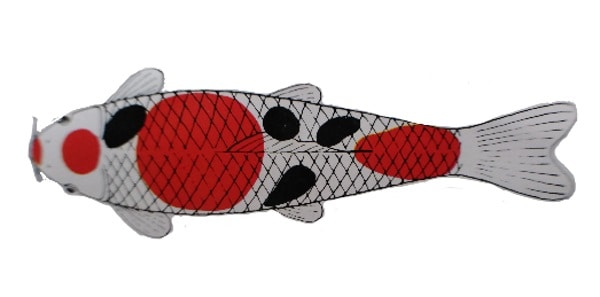
Fig 4-18
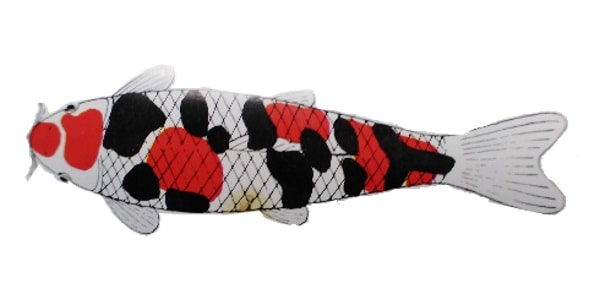
Fig 4-19
Head Hi:
- Don’t let the red (Hi) cover the eyes, jaws, cheeks, or nose.
- Leave a white area on the tail.
- Symmetrical red patterns are more desirable.
- Fins should remain uncolored.
Sumi Markings:
- The best Sanke koi have no Sumi on their heads.
- A large Sumi mark on the shoulder is highly valued (see Fig. 19).
- Two types of Sumi markings exist:
- “Tsubo-Sumi”: located on white skin (preferred, see Fig. 4-20).
- “Kasame-Sumi”: located on red patches (see Fig. 4-21).
- Tsubo-Sumi markings are more desirable and should be symmetrical and roundish.
- Limit Sumi spread on the back half of the body.
Fins:
- Ideally, fins have three black stripes.
- Fewer stripes create a more elegant look.
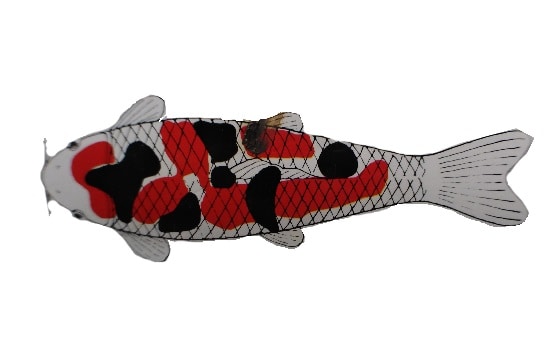
Fig.4-20
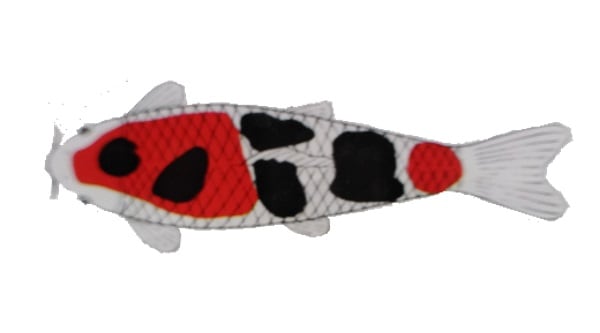
Fig. 4-21
Fig. 4-22
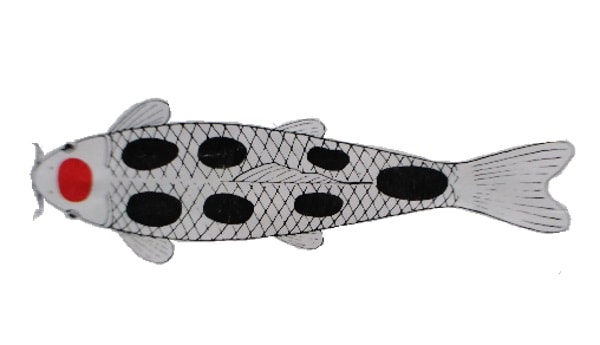
Fig. 4-23
Different Types of Sanke Koi fish
Aka-Sanke
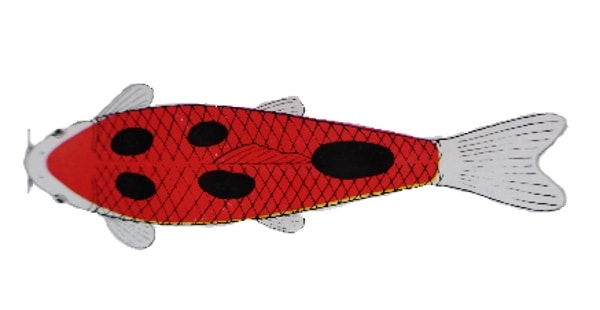
The koi in question seems to be a Taisho-Sanke with extensive red markings reaching from head to tail. While impressive, it might lack some elegance.
Koi, or Nishikigoi, are stunning ornamental fish originating in Japan. These vibrant and diversely colored beauties are popular additions to ponds and tanks. Among the most captivating varieties is the Aka-Sanke, famous for its bold red and white coloration.
Also known as Taisho-Sanke, the Aka-Sanke is easily identified by its three defining colors: white, red, and black. White dominates the body, with red and black markings gracing the head, fins, and tail. Red symbolizes energy, while black represents depth and strength.
With its striking appearance and powerful symbolism, the Aka-Sanke is a treasured choice for koi enthusiasts. In Japan, koi are associated with good fortune, prosperity, perseverance, and strength. The Aka-Sanke, with its bold colors and markings, embodies these qualities beautifully.
To thrive, Aka-Sanke need a suitable habitat. This means clean, well-oxygenated water in a pond or tank at least 500 gallons large. As active swimmers, they require ample space to roam. The ideal water temperature range is 65-75 degrees Fahrenheit.
Feeding is simple: pellets, flakes, and live/frozen foods like brine shrimp, bloodworms, and daphnia are all suitable options. Maintain a balanced diet and avoid overfeeding to prevent health issues.
Captivating for generations, the Aka-Sanke’s stunning appearance and symbolic meaning make it a favorite among koi enthusiasts. Its easy care makes it a great choice for both beginners and experienced fishkeepers alike. Whether you seek to enhance your pond or simply appreciate the beauty of these majestic creatures, the Aka-Sanke koi is sure to impress.
Doitsu-Sanke
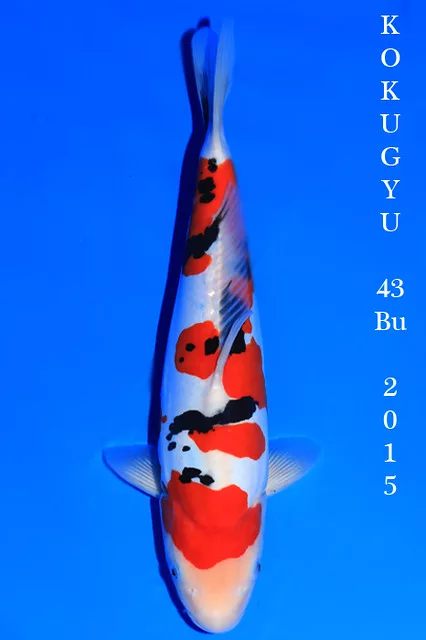
Doitsu-Sanke: The Sleek and Striking Koi Variety
Easily recognizable for their:
- White body: Like a blank canvas for vibrant markings.
- Red markings: Bold and eye-catching, reminiscent of a Kohaku.
- Black spots: Unique pattern adding depth and beauty.
- Metallic sheen: A mesmerizing shimmer caused by a special mutation.
- Smooth, sleek appearance: Fewer scales than other koi, creating an elegant look.
- Large size: Can reach up to 30 inches, making a grand statement in any pond.
More than just looks:
- Hardy and adaptable: Thrive in various water conditions, perfect for beginners and experts.
- Unique personality: Can be playful and interactive, adding joy to your water garden.
Caring for your Doitsu-Sanke:
- Balanced diet: Offer both plant and animal-based foods, specifically formulated for koi.
- Clean water: Regular changes and proper filtration are crucial for their health.
Doitsu-Sanke family:
- Doitsu-Aka-Sanke: Similar to Taisho-Sanke with a more prominent red color.
- Fuji-Sanke: Features silver lumps on the head, adding a distinct charm.
- Koromo-Sanke: Black or blue reticulation on each scale creates a mesmerizing effect.
- Kanoko-Sanke: Unique speckled pattern adds a touch of whimsy.
- Sanke-Shusui: Combines Sanke markings with the blue sheen of a Shusui.
- Budo Sanke: Showcases a pattern resembling Budo Goromo with solid black markings.
- Yamato-Nishiki: A stunning Hikarimoyo variety with a captivating color combination.
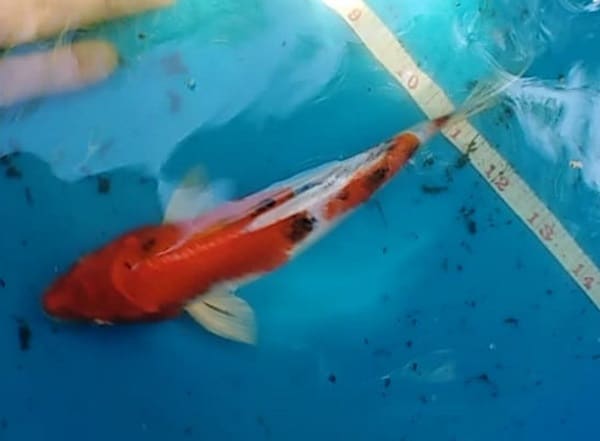
The Yamato Nishiki koi, known for their metallic sheen, are considered a “metallic Sanke.” They share the same judging criteria as the regular Sanke koi. These stunning fish are created by breeding Sanke with Platinum Ogon, resulting in their vibrant coloration.
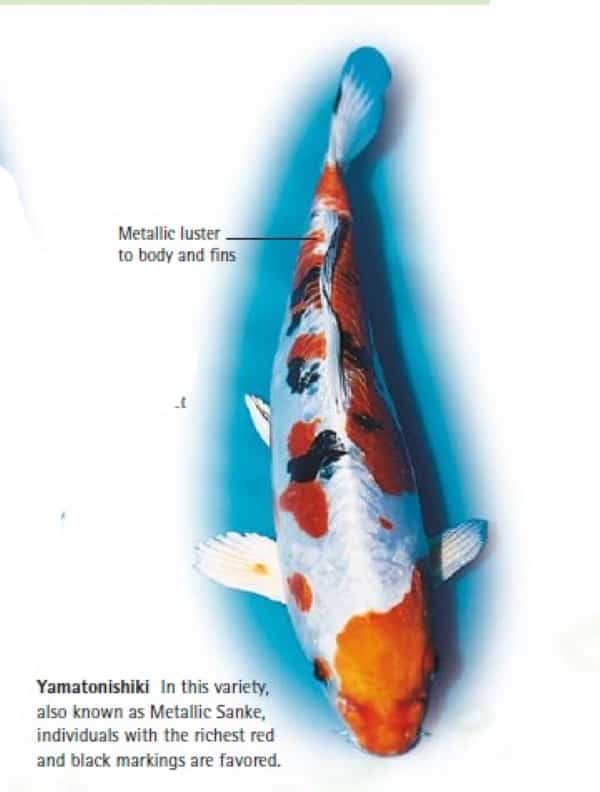
The Sanke koi variety
In this variety of koi, also known as Metallic Sanke, individuals with the richest red and black markings are prized. The name “Kinginrin” means “Golden, silvery scale” and refers to the sparkling scales that sometimes appear on these koi.
Distinguishing Sanke from Showa
Sanke and Showa are two popular varieties of koi that can be difficult to distinguish from each other. Sanke koi are typically white with red and black markings, while Showa koi are black with red and white markings. However, there is some variation within each variety, and some koi may have markings that are more characteristic of the other variety.
The history of Sanke koi
The Sanke koi variety originated in the reign of the Japanese Emperor Yoshihito (1912-1926). The proper name for a Sanke koi is Taisho Sanshoku or Taisho Sanke, which is commonly abbreviated to Sanke.
More about Sanke koi
Sanke koi are popular among hobbyists and koi show participants. They are known for their beauty and elegance. If you are interested in learning more about Sanke koi, there are many resources available online and in libraries.
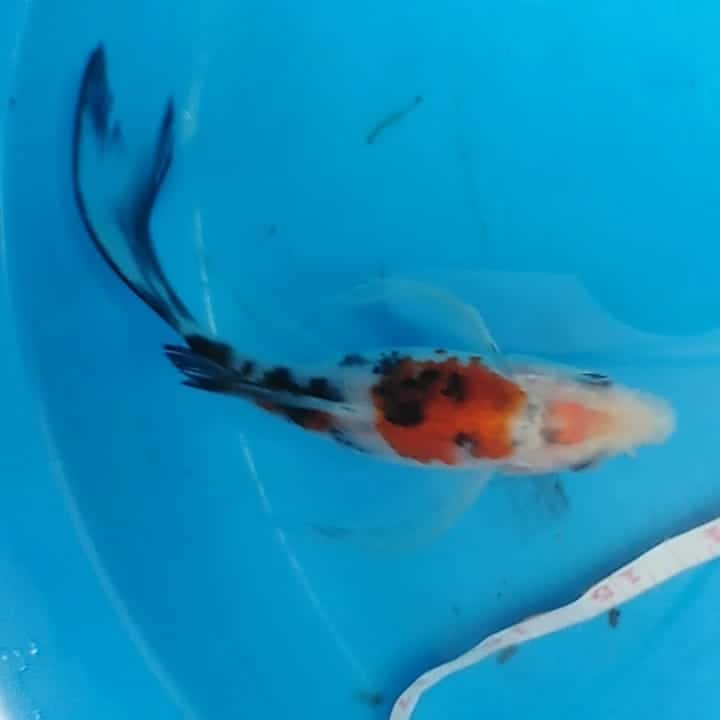
Conclusion
The Sanke koi fish is a true gem of the aquatic world, offering a captivating blend of beauty, tradition, and symbolism. Whether you’re a seasoned koi enthusiast or simply drawn to their aesthetic charm, the Sanke koi is sure to leave a lasting impression. So, if you’re looking to add a touch of elegance and good fortune to your pond, consider welcoming a Sanke koi into your aquatic haven.
Frequently ask questions FAQs
-
What is Gosanke koi?
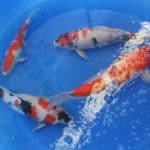
Gosanke (goh-SAHN-keh) is a classification of koi fish that is comprised of three subcategories that includes Kohaku, Sanke and Showa. … This group remains the most popular choice for enthusiasts and is usually one of the first types of koi fish to find its way into a pond or tank
-
where are sanke koi found in japan
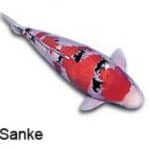
the Sanke (also known as a Taisho Sanshoku). This tri colored Koi (white body with red and black markings) was first seen in 1868-1912. In 1915, a 15 year old Sanke variety Koi was displayed for the first time. In 1927 Taisho Sanshoku, also called Taisho Sanke and Sanke, were developed from Kohaku about 80 years ago in 1918 in the era of Taisho
-
how to pick show sanke koi
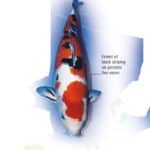
There should not be any red in the fins, lJl1less very tight to the body. Be careful choosing a young sanke with many black stripes in the pectoral fins. These sometimes develop too much black at a later stage. Again, as in all koi, look for broad shoulders and large pectoral fins for good growth potential
-
what is the difference between showa koi and sanke koi
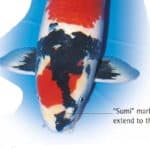
The most obvious difference between the Sanke and Showa is the presence of sumi on the head. Generally, Sanke will have only two colors on its head — white and red, with no sumi present. … In contrast, you should see all three colors, including black, on the heads of Showa. Bold Showa patterns begin on the face.
Learn more about Koi Fish Facts
You may also like
- https://www.giobelkoicenter.com/koi-fish-meaning/
- https://www.giobelkoicenter.com/most-expensive-koi-fish/
- https://www.giobelkoicenter.com/matsuba-koi/
- https://www.giobelkoicenter.com/koi-egg-bound/
- https://www.giobelkoicenter.com/metronidazole-for-fish/
